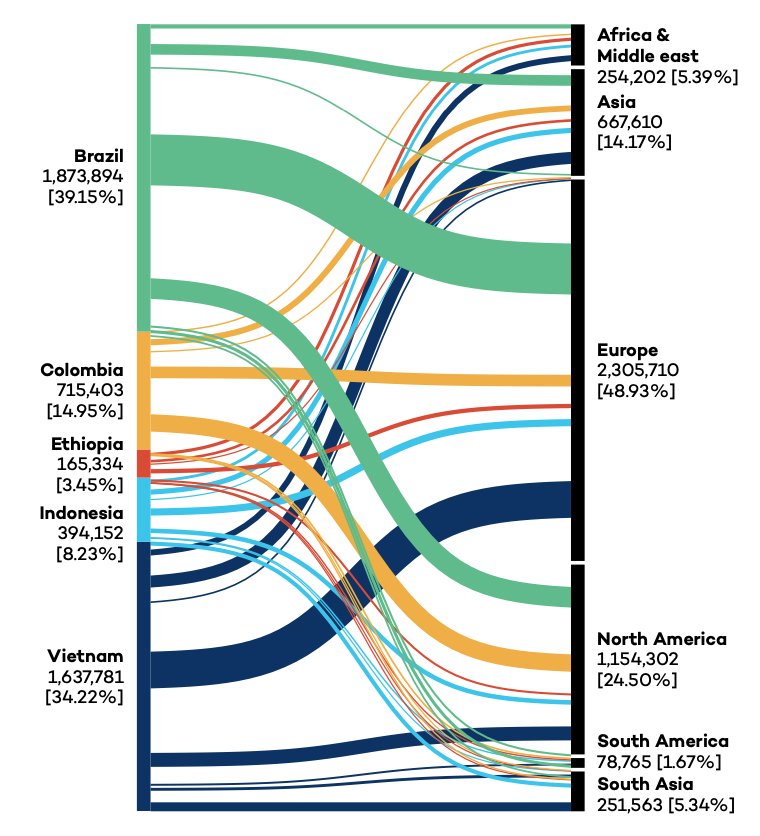This week’s curiosity box has
- How big is big food?
- The story of a cup of coffee
- What is happening in Yemen?
1. How big of an impact does Big Food have on us?
The term Big Food refers to the large multinationals corporations that produce most of the household food products. Some of the biggest companies are Nestle, PepsiCo, Coca-Cola, Kraft-Heinz, and Tyson Foods. Nestle on its own, has more than 2000 brands under its belt. They are called Big Food for a reason; last year, these five companies alone made a combined revenue of $275 billion.

These companies make sure their products are accessible and cheaper for us as consumers by striving for efficiency gains in production – the most accessible foods are not necessarily the most nutritious. The level of efficiency gains is so high, that Tyson Foods is able to process 40 million chickens per week, i.e. 2 billion chickens a year.
These Big Food companies have a direct impact on our eating habits. So much so that these changes have caused obesity rates to surpass hunger and become the world’s leading health and nutrition problem.
And it is not just with poultry and meat; Iceberg lettuce is an example of a vegetable that is mass produced but not necessarily nutritious. It is one of the most widely used salad leaf – the McDonalds and KFCs of the world, premade salads, and even Subway. (Next time observe what veggie is added the most to your sub).
The public’s concern is visible; the google trend predictor shows that people are keen to know more about Big Food than Big Pharma, Big Tech, and Big Oil companies. But I just don’t think we realise how much these big food companies have crept into our diets and kitchens.

Source: Google Trends
Off all the foods that is in my kitchen, one item that has crept well into my life is coffee.
2. How big is coffee?
One of the most ubiquitous things in my day-to-day life is coffee. I contribute three cups to the 2 billion cups of coffee consumed every day all over the world. If each cup has the recommended 7 grams of ground coffee, that means the whole world consumes 14,000 tons of coffee per year. That is the weight of 42 Boeing 747s. The major contributors to the 14,000 figure are the Finnish where the per capita consumption of coffee is 12 kg per year.
The coffee industry is massive, and the value for the whole industry is expected to reach $600 billion by 2025. The graph below shows the 5 countries (Brazil, Colombia, Ethiopia, Indonesia, and Vietnam) that contribute to 68% of the coffee produced all over the world.
The % in brackets on the right represents the proportion of the total volume of coffee imported from the five countries.

Source of image: https://www.iisd.org/sites/default/files/publications/ssi-global-market-report-coffee.pdf
This coffee pandemic we are in began when the process of roasting, grinding, and brewing coffee was discovered. History accounts say that all of this occurred in Sufi Shrines in Yemen in the 15th Century where monks consumed coffee to conduct prayers all night. Despite being the starting point for such a massive industry, Yemen is now stuck in a terrible crisis.
3 – What the hell is happening in Yemen?
Close to 24 million people out of a population of 29 million in Yemen are in dire need for humanitarian support – making it the biggest crisis in history. The crisis began because the Shia majority Iran and Sunni majority Saudi Arabia are fighting against each other in Yemen.
The problem exacerbated during the Arab springs when people said enough is enough with autocratic rulers. So Saudi Arabia oversaw the replacement of the president. But this transition was a failure and Yemen continued to have massive unemployment, food insecurity, and many other socio-economic problems. From the eyes of the public, they felt that they were cheated. And so, an uprising ensued.
From Saudi Arabia’s eyes, they thought that Iran was supporting the rebels to fight against the president they chose, i.e. them. So, they retaliated with military force and the rebels further retaliated, leaving Yemen stuck in between.
The state is unacceptable and the cost to all of this is just unmeasurable. One link after the other in the UNICEF website unravels more about the problem in Yemen at the moment.


Your article started off with an interesting and dipped into the luxury of coffee but ended up with a nostalgic effect. It’s very disturbing to know the unrest that prevails….
Insightful Arun!! Craving for more on each of these topics.. I would have preferred 3 blogs